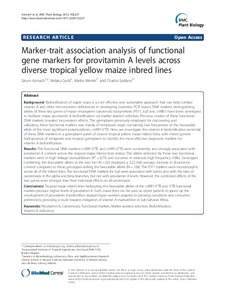| dc.contributor.author | Azmach, G. |
| dc.contributor.author | Gedil, M. |
| dc.contributor.author | Menkir, A. |
| dc.contributor.author | Spillane, Charles |
| dc.date.accessioned | 2019-12-04T11:03:59Z |
| dc.date.available | 2019-12-04T11:03:59Z |
| dc.date.issued | 2013 |
| dc.identifier.citation | Azmach, G., Gedil, M., Menkir, A. & Spillane, C. (2013). Marker-trait association analysis of functional gene markers for provitamin A levels across diverse tropical yellow maize inbred lines. BMC Plant Biology, 13(1), 227. |
| dc.identifier.issn | 1471-2229 |
| dc.identifier.uri | https://hdl.handle.net/20.500.12478/1303 |
| dc.description.abstract | Background: Biofortification of staple crops is a cost effective and sustainable approach that can help combatvitamin A and other micronutrient deficiencies in developing countries. PCR -based DNA markers distinguishingalleles of three key genes of maize endosperm carotenoid biosynthesis (PSY1, lcyE and crtRB1) have been developedto facilitate maize provitamin A biofortification via marker assisted selection. Previous studies of these functionalDNA markers revealed inconsistent effects. The germplasm previously employed for discovering andvalidating these functional markers was mainly of temperate origin containing low frequencies of the favourableallele of the most significant polymorphism, crtRB1-5_TE. Here, we investigate the vitamin A biofortification potentialof these DNA markers in a germplasm panel of diverse tropical yellow maize inbred lines, with mixed geneticbackgrounds of temperate and tropical germplasm to identify the most effective diagnostic markers forvitamin A biofortification.Results: The functional DNA markers crtRB1-5_TE and crtRB1-3_TE were consistently and strongly associated withprovitamin A content across the tropical maize inbred lines tested. The alleles detected by these two functionalmarkers were in high linkage disequilibrium (R2 = 0.75) and occurred in relatively high frequency (18%). Genotypescombining the favourable alleles at the two loci (N = 20) displayed a 3.22 fold average increase in _-carotenecontent compared to those genotypes lacking the favourable alleles (N = 106). The PSY1 markers were monomorphicacross all of the inbred lines. The functional DNA markers for lcyE were associated with lutein, and with the ratio ofcarotenoids in the alpha and beta branches, but not with provitamin A levels. However, the combined effects of thetwo genes were stronger than their individual effects on all carotenoids.Conclusions: Tropical maize inbred lines harbouring the favourable alleles of the crtRB1-5_TE and 3_TE functionalmarkers produce higher levels of provitamin A. Such maize lines can be used as donor parents to speed up thedevelopment of provitamin A biofortified tropical maize varieties adapted to growing conditions and consumerpreferences, providing a route towards mitigation of vitamin A malnutrition in Sub-Saharan Africa. |
| dc.format.extent | 1-16. |
| dc.language.iso | en |
| dc.subject | Carotenoids |
| dc.subject | Vitamin A |
| dc.subject | Provitamins |
| dc.subject | Dna |
| dc.title | Markertrait association analysis of functional gene markers for provitamin A levels across diverse tropical yellow maize inbred lines |
| dc.type | Journal Article |
| dc.description.version | Peer Review |
| cg.contributor.crp | Maize |
| cg.contributor.affiliation | International Institute of Tropical Agriculture |
| cg.contributor.affiliation | National University of Ireland |
| cg.coverage.region | Africa South Of Sahara |
| cg.isijournal | ISI Journal |
| cg.authorship.types | CGIAR and advanced research institute |
| cg.iitasubject | Biofortification; Maize |
| cg.journal | BMC Plant Biology |
| cg.howpublished | Formally Published |
| cg.accessibilitystatus | Open Access |
| local.dspaceid | 78706 |

